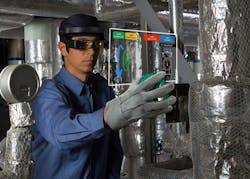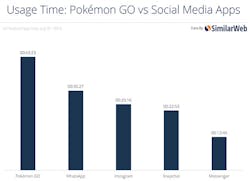Have you noticed all those random people in your city, aimlessly meandering into streets, stumbling into gardens and mobbing highly populated landmarks? Even though they exhibit the same behavior you would expect from a zombie – slumped shoulders, drooping heads, and a whole lot of grunting — don’t worry. You can drop the bug out bag and put down your crossbow, because it’s not the end of the world. It’s only the beginning of the augmented one.
With the July 6 release of Pokémon Go, Nintendo’s free app for iOS and Android that allows you to catch the various pocket monsters IRL using your smartphone’s camera and GPS, the mainstream is getting its first real taste of augmented reality.
If you have been around a plant or factory floor lately, you could already be using AR wearables. Industrial smartglasses allow an environmental omniscience only previously realized in video games. They offer binocular vision, video recording and connect to the Internet of Things to display equipment operational data, such temperature and speed.
Moverio smart glasses and other Augmented Reality tools can be used for things other than catching monsters, such as boring things like helping to keep our society heated and powered.
Photo: Epson
Pokémon Go, the newest and now most popular AR, works a bit differently. Once downloaded, you create your avatar and unique name. That’s one of the tougher parts of the game, because the app on pace to become even more popular than Twitter, and it’s already been downloaded on more than 5% of ALL Android phones in the United States.
Once that’s done, you are ready to play, as long as you let developer Niantic access your location and camera info. Your phone then turns into a fairly accurate 3D map of your area, including building outlines, streets and water, with your avatar standing roughly where you are on that map.
Every so often, your phone will buzz and a Pokémon will appear on the map near you. Just tap on it and the screen goes into camera mode. It looks just like it would if you were about to take a picture, but with an animated mutant mushroom or rat hopping around. The object is to flick the pokeball at the bottom of the screen at the Pokémon in order to capture it in digital form. If at this point you’re asking why the heck this has become the most popular thing in America, Australia and New Zealand right now, (the only places it’s launched so far), just think of it as an unholy union of geocaching, hunting, and heroin.
Now do you see the allure?
Even if you don’t know understand why this is a thing, know that it is a thing and it may affect those closest to you.
As with all cultural phenomenon, you’ll get the people who find a way to take advantage of others, like the criminals in Missouri who used “lures,” normally used to bait wild Pokémon, to attract players to their location to rob them. Beanie Baby sellers did the same thing, only without the courtesy of a pistol whipping.
On the plus side, the only way to catch “wild” Pokémon and obtain the items needed to “catch ‘em all” is to get off your butt and explore your neighborhood. And to “hatch” incubated Pokémon eggs, you have to actually walk up to 10 km. Driving doesn’t work; I’ve tried. This means more people were out walking and getting exercise this weekend. If you have kids, you know how hard it is to get them out of the house and play sometimes.
And like the Nintendo’s Wii before it, it’s easy to see the merits of using this as an exercise incentive in retirement communities and assisted-living facilities.
But for us working class schmoes, it’s difficult to see any good coming from this, especially if you’re a people manager in an industrial space.
The best thing to do is to enforce a zero-tolerance policy toward Pokémon Go at the plant. Or at the very least during working hours.
Photo: Instagram/Splurt
First and foremost is safety. Not only do you have to worry if your crew will get to work without crashing because a rare Articuno flew over the expressway, but what happens at work?
Your fork lift operators may understand that playing games on the job could get someone seriously hurt or fired, but that new accounting hire who is wandering around the warehouse during lunch looking for Pokémon might not care as much.
This is different than regular smart phone use because this game promotes exploration, and while that’s fine if your name is Magellan or Vasco de Gama, it’s a dangerous practice on the factory floor. Heads should be on swivel at all times near machining equipment and welding operations, not looking down at a cartoon creature compass.
Next is productivity.
SimilarWeb data indicates that on July 8, Pokémon Go was being used an average of 43 minutes and 23 seconds a day, about 42% more than Instagram. And that’s with connectivity and server issues inherent in such a monumental software launch.
Even if this game took an extra 15 minutes a day from your workers’ productivity, expand that weeks and months. The app may be free to use, but it could cost your company untold amounts in wasted time.
This is all great news, though, if you are in the AGV or robot business. Is there a better case for automated guided vehicles running the floor? Humans could miss an unexpected pedestrian popping out from behind a stack of pallets; AGV’s can have a 360-deg view of their surroundings.
Whirlpool's Ohio plant has gone to AGVs for their material transport needs.
Photo: Seegrid
And robots don’t come into work 20 minutes late because they had to level up their Charizard to defend their team gym. They work 24/7 and don’t even know what a Charizard is.
This is a Charizard.
Robots taking jobs isn’t anything new. Pokémon Go isn’t going to make it worse.
It could make it better though. I did say this wasn’t the end of the world, after all.
With the entire world now seeing what AR can do, it’s illuminating millions of little minds to the possibilities of what apps they can create to augment reality. And maybe one of those killer apps will augment the human workforce enough to be more cost-effective than industrial robots.
That might sound overly optimistic or even crazy, but no more crazy then millions of people running around trying to catch invisible monsters.
Do you think Pokémon Go will affect your workplace? Let us know what you think!
About the Author
John Hitch
Editor, Fleet Maintenance
John Hitch, based out of Cleveland, Ohio, is the editor of Fleet Maintenance, a B2B magazine that addresses the service needs for all commercial vehicle makes and models (Classes 1-8), ranging from shop management strategies to the latest tools to enhance uptime.
He previously wrote about equipment and fleet operations and management for FleetOwner, and prior to that, manufacturing and advanced technology for IndustryWeek and New Equipment Digest. He is an award-winning journalist and former sonar technician aboard a nuclear-powered submarine where he served honorably aboard the fast-attack submarine USS Oklahoma City (SSN-723).







